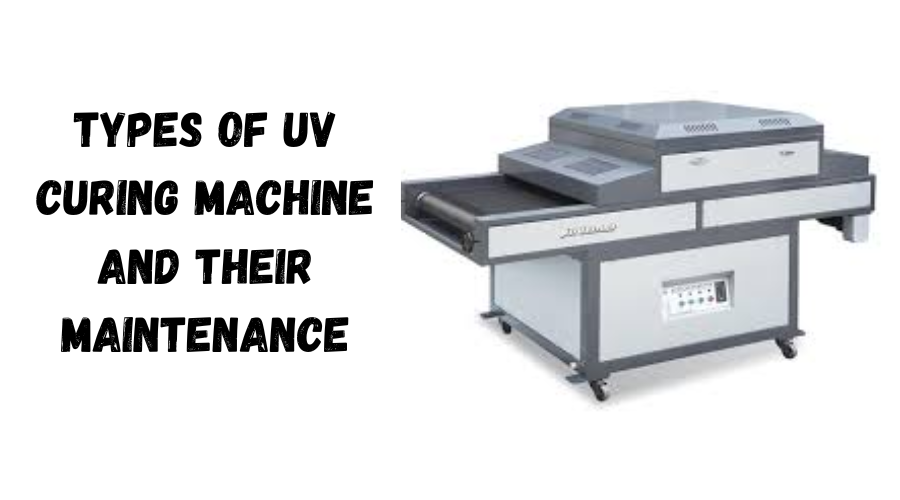.jpg)
Blogs
Types Of UV Curing Machine and Their Maintenance

Curing with UV light is very similar to baking a cake. As long as the temperature of the oven is correct and the batter stays in it long enough while being "cooked," a good quality cake will be produced. When curing with UV materials, if the materials receive the correct wavelength of light intensity for the specified amount of time, a proper cure will occur, regardless of whether the light is generated from an arc lamp, a microwave unit, or any UV LED. The properties of the light are what matter in the cure process of a UV ink, coating, and adhesive.
Choosing the right UV light source to install is like selecting the right oven for your kitchen. While some ovens may produce the same result, the ultimate choice will depend on other factors such as costs, size, features, quality or reliability. We know that buying equipment is a big decision and that is why in this blog we will ease the decision-making process for you by clarifying the differences between various UV curing machines and what to consider before making the big purchase decision.
Comparison of Different Types of UV Curing Machines
|
Type of Machine
|
Key Features
|
Best Fit Applications
|
Buyer Advantage
|
|
Conveyor UV Curing
|
Continuous belt system, uniform curing, supports high-volume production | Packaging, automotive components, electronics assembly | Maximizes throughput and minimizes bottlenecks |
|
Spot UV Curing
|
Pinpoint precision, localized curing, compact systems | Electronics assembly, medical devices, adhesives for small joints | Ensures accuracy where detail is critical |
|
Flood UV Curing
|
Coverage area is great and light exposure is uniform. | Coatings, displays, panels, protective layers | Guarantees even curing across large surfaces |
|
Handheld UV Curing
|
Portable and flexible and the small size is easy to maneuver. | Repairs, custom projects, small-scale production | Adds mobility and adaptability to workflows |
|
LED UV Curing
|
Energy-efficient with a long operational life. Delivers immediate start, and custom wavelength regulation. | Printing, adhesives, coatings, sustainable manufacturing environments | Reduces energy costs, lowers maintenance, eco-friendly |
|
Tunnel UV Curing
|
Enclosed curing environment, and perfect fit for larger or complex products | Wood finishing, automotive parts, large-format printing | Delivers consistent curing for bulky or high-value items |
What to Look Before Buying UV Curing Machine
Maintenance Ease
When examining a new UV light source, consider how simple it will be to repair and maintain for peak performance. What is the method to clean a soiled reflector? How fast can you change the bulb? What is the price of spare parts? These are vital considerations that matter a lot in the long run. Certain arc lamps offer rapid-change features, featuring lamp modules that can be swapped out swiftly and effortlessly like a toner cartridge, whereas alternative designs necessitate almost taking apart the system for a standard procedure. For LED sources, you should assess if the LED array can be serviced in the field, or if the whole unit needs replacing in case of an issue. Certain LED designs include plug-in modules to ease on-site maintenance. Overall, uncomplicated wiring with minimal connectors and the least number of moving components simplifies maintenance.
Certain UV systems enable easy adjustments to power output levels, offer insights into the state of the power supply or cooling system, and deliver diagnostic details in case of issues. Certain LED systems protect the array by tracking vital factors of the systems, including cooling temperature and coolant flow rate. More advanced LED control systems offer “addressability” that allows you to selectively activate or deactivate different sections of the array to fit various sized components. When evaluating a light source, you should think about how it will fit into your curing line or equipment and if it possesses the necessary interface features
Evaluate the Energy Efficiency
What makes UV light curing systems better than traditional curing counterparts is their enhanced energy efficiency and reduced environmental impact when compared to conventional curing methods. When selecting a system, your emphasis should be on reducing your operational expenses so choose a model that has reduce energy consumption and does not cause unnecessary waste. , thereby lowering operating costs and promoting sustainability.
Consider Your Budget
When obtaining a UV light curing system, consider not only the initial purchase price but also the overall cost of ownership. This includes aspects such as upkeep, energy consumption, and replacement components. A system that comes with a greater initial investment may offer greater long-term value if it requires less maintenance and consumes less energy.
Technical Support
All suppliers guarantee excellent service and assistance. How can you make sure that you choose someone who assists you when facing an issue or requires technical support? Certain behaviors you can notice prior to purchasing serve as reliable signs of what to anticipate later. Ensure that your product is backed by comprehensive operating manuals and technical documentation. The vendor’s site may also include technical documentation such as manuals, downloads, and useful videos. Vendors that have their own repair facilities and service staff are a positive indication. In the development phase, suppliers ready to offer testing equipment and on-site assistance to guarantee a solid process might also be more inclined to provide increased support in the long term.
Conclusion
It’s easy to think that UV curing equipment serves the same function. The question is, are you willing to take the risk of acquiring the wrong UV curing equipment to potentially slow your operation down, waste energy, or even compromise quality? The scale of production, level of accuracy needed, and type of materials that need curing will determine which machine will be right for your operation.
For example, be prepared for mass production. Conveyor or tunnel systems will probably be the most effective. If your work requires incredible accuracy, use spot curing systems. If you need something portable, handheld tools will give you maximum mobility. As for operating costs, LED systems are something to consider for better ROI over the life of the equipment.
